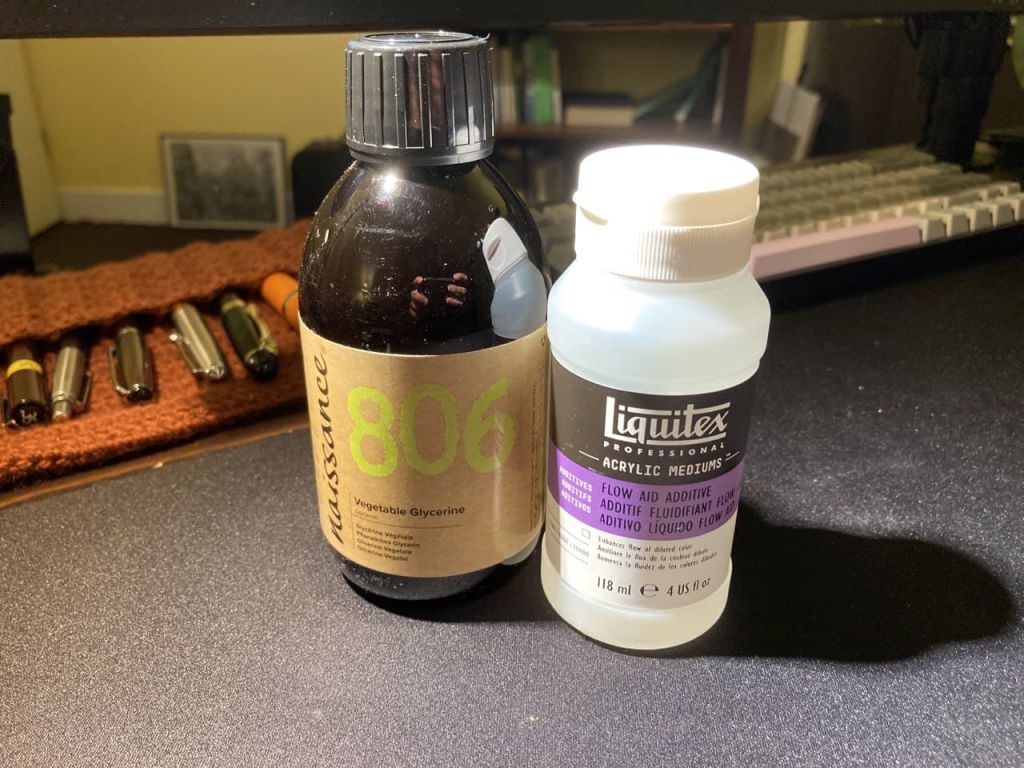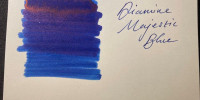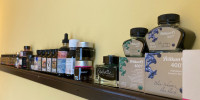How To Lubricate Fountain Pen Ink Without Ruining It

If you like a particular ink but it is too dry for your taste, you can lubricate fountain pen inks yourself easily. But you want to use the right ingredients and dose, or you'll ruin your ink.
You can lubricate fountain pen inks by adding a small amount of food-grade glycerin or dishwasher detergent to your ink. Typically, you'll need three drops of glycerin to one ounce of ink. However, some people report needing much less. When diluting inks, it is recommended to work in small batches.
There is some precision involved, and if you do it wrong, you may ruin your entire bottle of ink. Generally, you'll need much less lubrication than most people initially think. Read on to learn the fail-safe method I use to nail it every time.
In this article:
Lubricate Inks Without Ruining Them
The correct method to lubricating inks is to add lubrication in small increments and test the ink flow before adding more. Also, it would be wise to mix a small amount of ink first in order to determine the correct ratio, before lubricating (and potentially ruining) an entire bottle. Remember, you can always add more, but you can never extract.
I tend to mix in a separate flacon, and never in the main bottle. I mix up to maximum 1/2 oz or 30 ml at a time, but never more.
Most common ink lubrication recipes
There are two ways of increasing lubricity in ink: the first is to reduce surface tension in the ink, and the second is to increasing lubricity directly. Both require different lubricants, and while you can lubricate ink using all kinds of stuff, the most common are:
- Food-grade glycerin
- Dishwasher detergent
- Kodak Photo Flo
- Luiqitex Flow-Aid
- One drop of glycerin and one drop of Luiqitex
Tools needed
- Ink sample vial to decant a small ink batch
- Toothpick for dosing your lubricant
Method
- Decant a small amount of ink first. I recommend working on a batch size you're willing to lose, and lose 2-3 times over, since it might take some tries before you get the dosage right.
- Extract a dose of lubricant using your toothpick and add it to your ink batch, mixing it ink gently and giving it time to dissolve.
- Test your lubricated ink to notice the writing experience. Also try the ink for a couple of days in different pens, and notice any nib creep, leaking, burping, or other unwanted effects. Increase or decrease the dosage accordingly.
- Mix a larger batch for future use once you're satisfied with the dosage.
The dose is king: too much and your ink will be expelled from your pen uncontrollably and continuously; too little and you won't notice any benefits.
If you're unwilling to mix the ink yourself, you could instead buy lubricated ink. Here's a list with my favorite lubricated fountain pen inks.
Below I'll discuss the different lubricants and their dosage in more detail, as well as discuss the advantages and disadvantages of lubricating fountain pen inks.
Lubricate Using Food-Grade Glycerin
Glycerin is a byproduct of making soap. It attracts and retains moisture. Glycerin affects lubricity directly and is the preferred method of increasing ink flow. It is widely available and very affordable.
Get the vegetable organic food-grade glycerin. Food-grade quality will prevent any contamination of your ink. You will only need a tiny drop for each bottle of ink so one bottle will last you a lifetime (in theory, since it has a shelf life, more on that later).
It will darken the ink slightly, but noticeably. If this is a problem for a specific ink, you could either get a lighter shade of ink, or use another lubricant (see below).
Glycerin is highly water-soluble, so if you add it to your permanent inks, your ink will bleed when coming into contact with water.=
Dip a toothpick into the glycerin to fetch a small drop and mix it into the ink bottle.
Shelf life of Glycerin
An unopened bottle will last up to five years when stored in a cool and dry place. Opened bottles will last between 12 and 24 months, so plan on repurchasing a bottle every two years or so. Glycerin will dry out over time. You can test whether glycerin is still good for use by adding a couple of drops of water, or simply leaving the bottle uncapped - it will pull moisture from the air. If it doesn't rehydrate, it is no longer good for use.
Due to this shelf life and the fact that you'll need only a very small amount, I recommend getting a small bottle at a time. I buy 250ml at a time, which is way too much but I can't find a cheaper product around.
Lubricate Using Dishwashing Detergent
Dishwashing detergent is a surfactant, which can be used to reduce surface tension, improving the ink flow. It doesn't directly affect lubricity like glycerin.
Most people have detergent readily available and it is extremely cheap. You can start lubricating straight away. I've tested detergent myself and found you only need an extremely small amount. I didn't like the way it behaved in the pen, it took a long time to flush out entirely. I've probably used way too much.
"soap is known to leave a residue when it combines with the salts found in tap water (which your ink maker may or may not have used)"
- mhosea at FP Geeks Forums
Another disadvantage of detergent is that it will wear away any lubrication of your piston mechanism, making it a poor choice for piston fillers.
Detergent will increase the flow substantially, so you'll only need a tiny drop for each bottle, less if you're mixing a smaller amount of ink. I use a pin point (or: toothpick point) for each 1/3 oz batch of ink. If you add too much lubricant, the ink will come running out of the pen uncontrollably.
It won't affect the color much, like glycerin will.
Lubricate Using Kodak Photo Flo
Kodak Photo Flo is also a surfactant, but in contrast to dishwasher detergent, will leave no residue. It's the better option, but also more costly. A similar product that also has an antibacterial agent in it is Cuddles Flo by Organics studio, a favorite with calligraphy pen users. Or you could use a laboratory cleaning surfactant, like Biopharm Triton X-100.
I personally have no experience with any of these products, so I can't make recommendations, although I have seen many pen users recommend the first two on fountain pen forums.
Lubricate Using Liquitex Flow-Aid
Another similar product is Liquitex Flow-Aid, which was first discovered by Maurizio on the Fountain Pen Network forums. He adds one drop of glycerin and one drop of Liquitex Flow-Aid to his bottles, which substantially improves ink flow without really affecting dry times.
Liquitex Flow-Aid is also a surfactant, so it reduces surface tension, improving ink flow. It is originally a surfactant for use in acrylic paints, but it can be safely used in all water-based inks, including fountain pen inks.
Liquitex recommends a ratio of one part Flow-Aid on 20 parts acrylic paint or other water-based ink. Maurizio recommends 1 to 2 drops of ink to a 45ml (1.5oz) bottle of ink at most.
Pros and Cons of Lubricated Inks
Advantages
- Improved ink flow
- Smoother writing - lubricated inks have a pleasant round or velvety feel to them
- More ink on the page will result in more saturated writing
Lubricated inks have a pleasant round or velvety feel to them, and they can really improve your writing experience if you enjoy smooth writing. Thanks to the lubrication, your pen will lay down more ink, resulting in more saturated writing as well.
Disadvantages
- Longer dry times
- More smudging
- Increased chance of leaking
- Too much lubrication results in burping and splurging
Adding lubricant to your inks will increase the dry time substantially, sometimes up to five minutes or more. Again, the dose is king. It will also make your ink more prone to smudging due to this. Your fountain pen will also be more prone to leaking, especially when using a surfactant, since the surface tension is lower.
Other types of fountain pen inks
If these disadvantages have changed your mind on what type of ink to get, there are alternatives. You could instead get fast-drying ink or permanent ink for outdoor use or crafts (using watercolors, for example).
All different types of ink are neatly laid out in my definitive fountain pen ink guide here, which I highly recommend if you're new to fountain pen ink and are currently trying to make up your mind on what ink to use.
Differences Between Lubricating and Diluting Inks
In general, there are three ways to make your fountain pen ink wetter. The first is diluting your ink with some sort of solvent, which would typically be water. The second is to lubricate your ink using glycerin or dishwasher detergent, which will improve the ink flow.
Technically, diluting the ink will make it actually wetter, while lubricating the ink will improve ink flow, but not really change the wetness of the ink, or, in other words, the viscosity. Lubricating the ink won't make the ink wetter, although it will feel like it thanks to the lubrication.
Diluting ink with water will reduce the lubricity of the ink instead of improving it. So while diluting an ink might make it technically wetter, the ink could feel actually dryer while writing. It will also shade more.
If you want to make your ink drier or increase shading, you can read my how-to article on how to dilute ink here.
Did you find the answer to your specific question?
👍 14 👎 0


Leave a comment